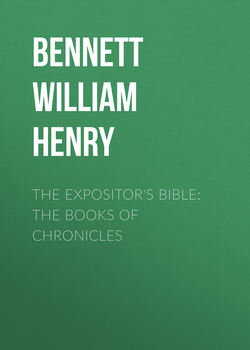The Expositor's Bible: The Books of Chronicles

Реклама. ООО «ЛитРес», ИНН: 7719571260.
Оглавление
Bennett William Henry. The Expositor's Bible: The Books of Chronicles
Preface
Book I. Introduction
Chapter I. Date And Authorship
Chapter II. Historical Setting
Chapter III. Sources And Mode Of Composition
Chapter IV. The Importance of Chronicles
Book II. Genealogies
Chapter I. Names. 1 Chron. i-ix
Chapter II. Heredity. 1 Chron. i. – ix
Chapter III. Statistics
Chapter IV. Family Traditions. 1 Chron. i. 10, 19, 46; ii. 3, 7, 34; iv. 9, 10, 18, 22, 27, 34-43; v. 10, 18-22; vii. 21-23; viii. 13
Chapter V. The Jewish Community In The Time Of The Chronicler
Chapter VI. Teaching By Anachronism. 1 Chron. ix. (cf. xv., xvi., xxiii. – xxvii., etc.)
Book III. Messianic And Other Types
Chapter I. Teaching By Types
Chapter II. David – I. His Tribe And Dynasty
Chapter III. David – II. His Personal History
Chapter IV. David – III. His Official Dignity
Chapter V. Solomon
Chapter VI. Solomon (continued)
Chapter VII. The Wicked Kings. 2 Chron. xxviii., etc
Chapter VIII. The Priests
Chapter IX. The Prophets
Chapter X. Satan. 1 Chron. xxi. – xxii. 1
Chapter XI. Conclusion
Book IV. The Interpretation Of History
Chapter I. The Last Prayer Of David. 1 Chron. xxix. 10-19
Chapter II. Rehoboam And Abijah: The Importance Of Ritual. 2 Chron. x. – xiii
Chapter III. Asa: Divine Retribution. 2 Chron. xiv. – xvi
Chapter IV. Jehoshaphat – The Doctrine Of Non-Resistance. 2 Chron. xvii. – xx
Chapter V. Jehoram, Ahaziah, and Athaliah: The Consequences of a Foreign Marriage. 2 Chron. xxi. – xxiii
Chapter VI. Joash and Amaziah. 2 Chron. xxiv. – xxv
Chapter VII. Uzziah, Jotham, and Ahaz.408 2 Chron. xxvi. – xxviii
Chapter VIII. Hezekiah: The Religious Value Of Music. 2 Chron. xxix. – xxxii
Chapter IX. Manasseh: Repentance And Forgiveness. 2 Chron. xxxiii
Chapter X. The Last Kings Of Judah. 2 Chron. xxxiv. – xxxvi
Отрывок из книги
Chronicles is a curious literary torso. A comparison with Ezra and Nehemiah shows that the three originally formed a single whole. They are written in the same peculiar late Hebrew style; they use their sources in the same mechanical way; they are all saturated with the ecclesiastical spirit; and their Church order and doctrine rest upon the complete Pentateuch, and especially upon the Priestly Code. They take the same keen interest in genealogies, statistics, building operations, Temple ritual, priests and Levites, and most of all in the Levitical doorkeepers and singers. Ezra and Nehemiah form an obvious continuation of Chronicles; the latter work breaks off in the middle of a paragraph intended to introduce the account of the return from the Captivity; Ezra repeats the beginning of the paragraph and gives its conclusion. Similarly the register of the high-priests is begun in 1 Chron. vi. 4-15 and completed in Neh. xii. 10, 11.
We may compare the whole work to the image in Daniel's vision whose head was of fine gold, his breast and arms of silver, his belly and his thighs of brass, his legs of iron, his feet part of iron and part of clay. Ezra and Nehemiah preserve some of the finest historical material in the Old Testament, and are our only authority for a most important crisis in the religion of Israel. The torso that remains when these two books are removed is of very mixed character, partly borrowed from the older historical books, partly taken down from late tradition, and partly constructed according to the current philosophy of history.
.....
The incident in iv. 34-43 differs from the preceding in having a definite date assigned to it. In the time of Hezekiah some Simeonite clans had largely increased in number and found themselves straitened for room for their flocks. They accordingly went in search of new pasturage. One company went to Gedor, another to Mount Seir.
The situation of Gedor is not clearly known. It cannot be the Gedor of Josh. xv. 58, which lay in the heart of Judah. The LXX. has Gerar, a town to the south of Gaza, and this may be the right reading; but whether we read Gedor or Gerar, the scene of the invasion will be in the country south of Judah. Here the children of Simeon found what they wanted, “fat pasture, and good,” and abundant, for “the land was wide.” There was the additional advantage that the inhabitants were harmless and inoffensive and fell an easy prey to their invaders: “The land was quiet and peaceable, for they that dwelt there aforetime were of Ham.” As Ham in the genealogies is the father of Cainan, these peaceable folk would be Cainanites; and among them were a people called Meunim, probably not connected with any of the Maons mentioned in the Old Testament, but with some other town or district of the same name. So “these written by name came in the days of Hezekiah, king of Judah, and smote their tents, and the Meunim that were found there, and devoted them to destruction as accursed, so that none are left unto this day. And the Simeonites dwelt in their stead.”86
.....